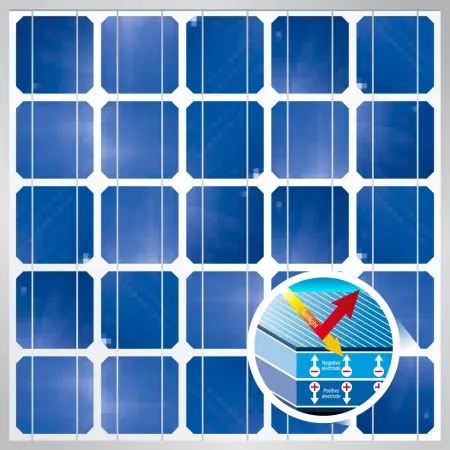
A photovoltaic cell (or solar cell) is an electronic device that converts energy from sunlight into electricity. This process is called the photovoltaic effect. Solar cells are essential for photovoltaic systems that capture energy from the sun and convert it into useful electricity for our homes and devices.
Solar cells are made of materials that absorb light and release electrons. The most common material is silicon, an abundant element in the Earth's crust. When photons (light particles) hit the solar cell, the electrons in the silicon are released. These free electrons generate an electrical current when they are captured.
Photovoltaic panels are made up of several groups of photoelectric cells connected to each other. Each group of solar cells forms a network of photovoltaic cells connected in a series of electrical circuits to increase the output voltage. At the same time, several networks are also connected in parallel circuits to increase the intensity of the electric current that the device is capable of providing.
The type of electric current provided by photovoltaic panels is direct current.
Structure and composition
The most common solar cells are made up of a layer of crystalline silicon with a thickness of approximately 0.3 mm. The manufacturing process is of a sophisticated and delicate level in order to achieve homogeneity of the material.
Silicon is currently the most used material in the creation of new photovoltaic cells. This material, which is the most abundant chemical compound found in the Earth's crust, is obtained by reducing silica. The first step is to create metallurgical silicon, 98% pure, from quartz stones derived from a mineral vein (the creation technique has nothing to do with sand).
Photovoltaic grade silicon must be transparent up to 99.999%. To obtain this amount of purity, silicon must be distilled into a special chemical compound. This special compound converts the distillate back into silicon.
The positive and negative zones of the photovoltaic cell
The electric field is generated from the different polarization of two areas of the solar cell. Generally, the top part has a negative charge and the rest has a positive charge to create the PN junction.
The P zone (positive zone or receiving anode) is an area that lacks electrons and is therefore positively charged. Generally, this configuration is achieved by adding a small part of boron to pure silicon that only has 3 valence electrons.
The N zone (negative zone or cathode or emitter) has excess electrons. Generally, this zone is formed by the diffusion of phosphorus that has 5 electrons in the last orbit.
Due to this difference in electric charge in the semiconductor material, the electric field responsible for pushing the electrons from the N layer to the P layer is produced.
The average conversion efficiency obtained by commercially available photovoltaic solar cells produced from monocrystalline silicon is lower than that of multilayer cells, typically gallium arsenide.
Currently, there are also new technologies in the production of solar panels that do not use silicon.
Operation of a photovoltaic cell
 If we connect a photovoltaic solar cell to an electrical circuit with resistance (consumption) and at the same time it receives solar radiation, an electrical potential difference will occur between its contacts. This voltage will cause electrons to flow through the circuit, generating an electric current.
If we connect a photovoltaic solar cell to an electrical circuit with resistance (consumption) and at the same time it receives solar radiation, an electrical potential difference will occur between its contacts. This voltage will cause electrons to flow through the circuit, generating an electric current.
Under these conditions, the photovoltaic cell acts as a current generator. Sunlight is made up of photons, which are particles with a certain amount of energy. When these photons hit the solar cell, they impact the electrons in the N layer of the silicon. If an electron absorbs the energy of a photon with sufficient energy, this electron will break free from the material, creating a "hole" that will be filled by another electron. This flow of electrons generates an electric current.
The current produced by a photovoltaic cell illuminated and connected to a load is the difference between its gross production capacity and the losses due to the recombination of electrons and photons. The efficiency of the cell depends on several factors, such as the quality of the material and the amount of sunlight hitting the cell.
Examples of solar cell applications
Solar cells have various applications in both small devices and large power generation systems. Here are some notable examples:
Small devices
- Calculators: They use solar cells to operate without the need for batteries. These calculators are common in offices and schools.
- Watches: Some watches use solar cells to recharge their battery, extending their life and reducing the need for frequent battery changes.
- Garden Lights: Solar garden lights have solar cells that capture the sun's energy during the day and use it for lighting at night, without the need for cables or consumption of electricity from the grid.
Residential systems
- Rooftop Solar Panels: Many homes are equipped with solar panels that convert sunlight into electricity for household use. This can significantly reduce electricity bills and dependence on non-renewable energy sources.
Industrial and commercial applications
- Solar Plants: Large solar installations use vast quantities of solar panels to generate electricity on a commercial scale, providing clean energy to thousands of homes and businesses.
- Electric vehicle charging stations: Some charging stations use solar panels to provide power to electric vehicles, promoting sustainability and reducing the load on the electrical grid.
Specialized applications :
- Satellites and space: Satellites and other spacecraft use solar cells to generate power in space, where sunlight is abundant and constant.
- Portable and emergency devices: Solar cells are used in portable chargers for mobile phones and emergency equipment, ensuring power supply in critical situations.